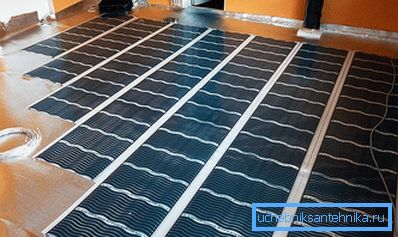What a warm floor to choose
Heated floors are increasingly finding their supporters. They have long been transformed from an attribute that speaks about the welfare of the owner into a reliable and affordable method of heating. Increasingly, home / apartment owners are installing underfloor heating as the main heating system. The effectiveness and convenience of this method is confirmed by years of operation and positive consumer reviews.
In the article we will tell what kind of heated floor to choose under the tile, consider which embedded systems are better - water or electric? Let's try to evaluate different types of floors in terms of technical and operational characteristics.
Water embedded system

Water floor heating is a network of pipelines of polymer pipes through which coolant circulates, in this case hot water.
Water floor heating is connected to the heating boiler, while connection to the centralized heating network is considered illegal.
The advantage of the system:
- Economy, has a 20-30% lower energy consumption compared with radiator heating.
- The comfort of heating for the human body (temperature at the feet is +22? С, at the level of the head is +18? С).
- Injury protection and fire safety - there are no surface areas with high temperature.
The disadvantages of the system include the inertia of entering the operating mode, the complexity of installation, the possibility of leakage and limited access to the repair site.
Electric cable floors

Electric floors are divided into types:
- cable;
- ultraviolet;
- core floor systems.
The basis of cable heating is a resistive cable, 2.8–7.5 mm thick with nichrome wire inside. With the passage of electrical current of the mains, heat is generated, warming the cable to +70? C. At the same time, the device is capable of developing power up to 110 W / m ?. There are designs with two cores inside. They use a semiconductor matrix as a heat radiator.
It is laid under a concrete screed with a thickness of at least 30 mm and is covered with tiles or ceramic granite. Heating cable can be laid in the floor and walls. It has an average energy efficiency, comparable to convector heaters.
Electric floor heating has a high level of security and can be used as the main heating.
The disadvantage of the system is low maintainability and serial connection to the electrical circuit: if one section is broken, the entire cable fails. The number of disadvantages can be attributed to the high cost of the system.
Core systems

They consist of flexible thermomats - rolled-type strips with thermoelements embedded between polymer layers or carbon-structure rods. The width of one mat is 83 cm, has a length of up to 25 m, mats can be cut during layout. Thickness up to 3 mm. The rods are made of carbon-based composite, with the addition of silver. When applied to the rod voltage, it induces radiation from the ultraviolet, invisible to the human eye, spectrum. The rods in the mats are connected to the electrical network in parallel, which gives the system reliability - when one or more rods fail, the rest continue to work. It is possible to use the thermostat. Develops power up to 160 W / m ?.
Works in the range with the top temperature +70? C. It can be mounted not only under the floors of tiles and stone, but also under wooden floors. Lay under a screed or adhesive layer up to 10 cm thick.
It is used as an additional source of heating. Can be laid on the floor and walls. The disadvantages of the system are low, compared with film floors, the efficiency and difficulty of installation.
IPO or infrared film heaters

The basis of IPO is a heating film with a thickness of 0.2–0.4 mm. It consists of two layers of polypropylene with a melting point of 120? C, inside which the carbon structure is applied by the printer - carbon bands. With the passage of the network current strips emit heat, power up to 220 W / m ?. The strips are connected by a parallel wiring diagram and are powered from the electrical network through a thermostat. The temperature of the heating surface reaches +70? C.
The system has a high energy efficiency of 25% compared with convection heaters.
It can be used as the main source of heating. IPO is simply mounted, for laying no cement or glue coating is required, the film is laid directly on a concrete or wooden base and covered with floors. Can be localized on walls or ceiling. Integrated into the smart home system.
Decide which floor is better? It is necessary to take into account what source it will be used for and focus on the cost of energy carriers - gas or solid fuel, electricity.
If you chose electric floors, it is better to use IPO and rod for the main heating and cable system for additional heating of the room.
Video: how to choose a warm floor
If you are interested to learn more about underfloor heating, then we suggest you to watch a video that shows the advantages of underfloor heating, as well as the technology of their installation: